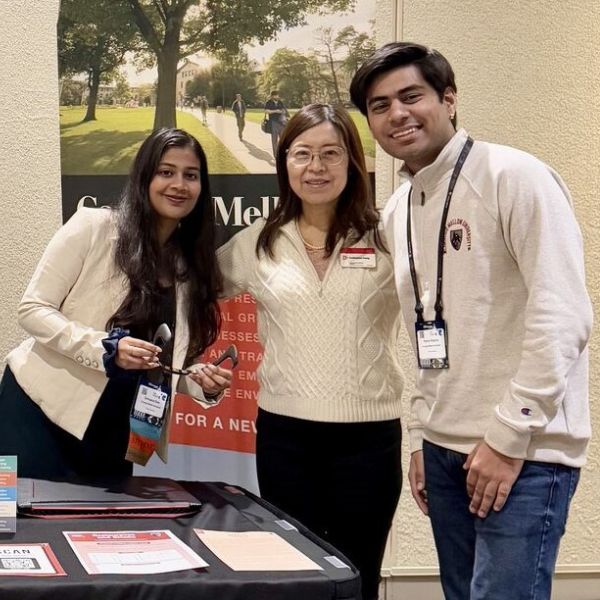Harsh Kataria
Integrated Innovation Institute
Integrated Innovation Institute / Master of Science in Software Management
Hometown: Gurgaon, India
-
You recently received Conference Funding provided by the Office of the Provost and Graduate Student Assembly. Tell us about the conference you attended and the work you presented there.
Along with Sahaana Das and advisor Dr. Catherine Fang, I was honored to attend the IEEE Rising Stars 2025 Conference at the Luxor Hotel, Las Vegas, in January 2025, where we presented NeuroRhythm—a project that uses Muse 2 EEG device to decode brain waves and analyze stress in real-time. Imagine explaining neural oscillations to a crowd under casino lights—it was equal parts exhilarating and surreal! The conference was brimming with innovation, from workshops on AI-driven sustainability to conversations with visionaries like Alberto Tam Yong, who designed the event’s iconic “circuit board” badges. A standout moment was demo-ing multiple fun EEG applications like BlinkPong, BlinkFlappyBird, and BlinkMorse. Imagine playing the famous flappy bird or Pong game using your brain and telecommuting in morse code. The “wow” moments from the attendees are forever captured in our minds. Thanks to CMU’s Provost/GSA funding, we returned with sharper technical storytelling skills, industry connections, and a renewed drive to push innovative solutions toward real-world impact.
-
How did you develop an interest in this subject area? What inspired this research?
My fascination with BCIs (brain-computer interfaces) started years ago during undergrad, while patenting a thought-transcription system using multi-channel EEG devices ranging from single to 32 channels. NeuroRhythm grew from asking: Could we make this tech accessible? Dr. Fang’s introduction to AI in neuroscience last semester reignited this curiosity, which was further fueled by her introducing me with the Muse 2 EEG device along with Karthick Chandrashekhar, who was a huge help in this project. Partnering with a team who shared a passion for human-centered AI felt natural. Dr. Catherine Fang’s mentorship helped us balance ambition with practicality. The “aha” moment came during a late-night brainstorming session: stress analysis and BCI awareness wasn’t just a technical challenge; it was a universal human experience. We wanted to build something that could help students, professionals, or even first responders. Turns out, Vegas audiences agreed—our poster sparked conversations about applications we’d never considered, from corporate to workplace wellness to trauma care.
-
What are your academic and/or professional goals?
Short-term, I’m laser-focused on becoming an innovation specialist at the intersection of tech and strategy. Think: designing AI tools that solve business problems before they escalate. Long-term, I aim to lead R&D initiatives for global challenges—scalable AI in health tech is high on that list. CMU’s MSSM program has been pivotal here; the project-based learning mirrors real-world consulting. Beyond titles, my north star is creating solutions that outlive their code—projects like our Ghughukhan village initiative, activities that support sustainable living beyond their scope.
-
How do you spend your time beyond academic work?
When I’m not debugging neural networks, you’ll find me planning hiking trips or traveling. As an avid trekker, being out in nature brings me great joy, and I can't wait to explore America’s great national parks. My teammates and I also adopted a remote Himalayan village post the pandemic—upskilling artisans, teaching kids English, math, computers, and Python, and proving that tech can thrive even without WiFi. For balance? I dabble in the kitchen learning to cook regional delicacies and bake the meanest garlic breads.
